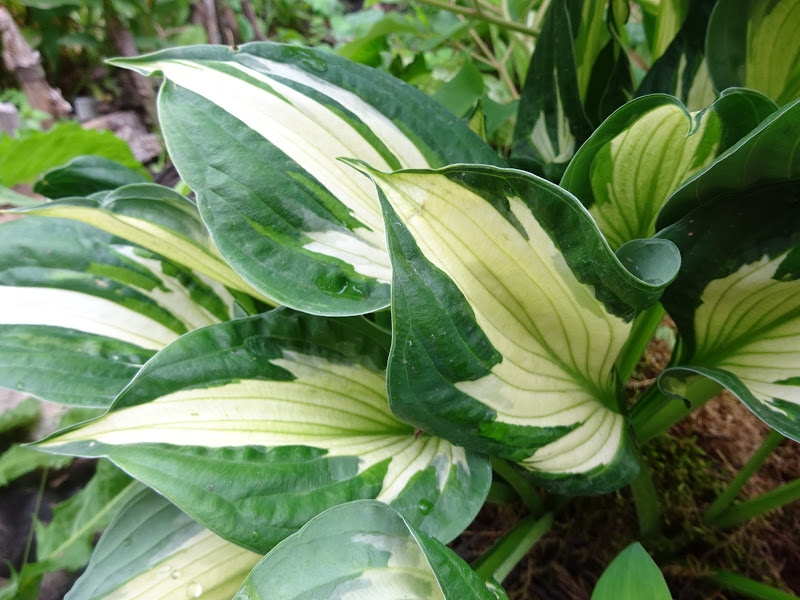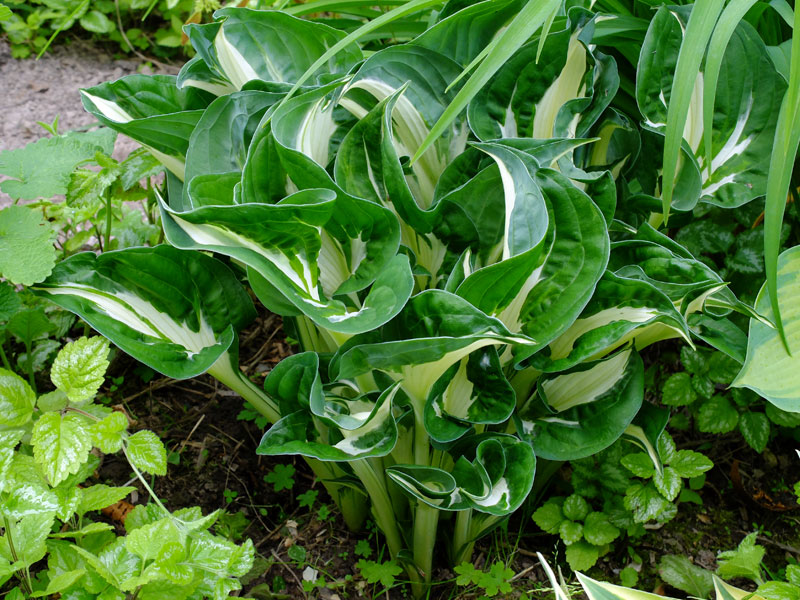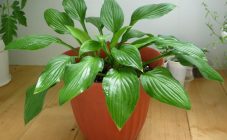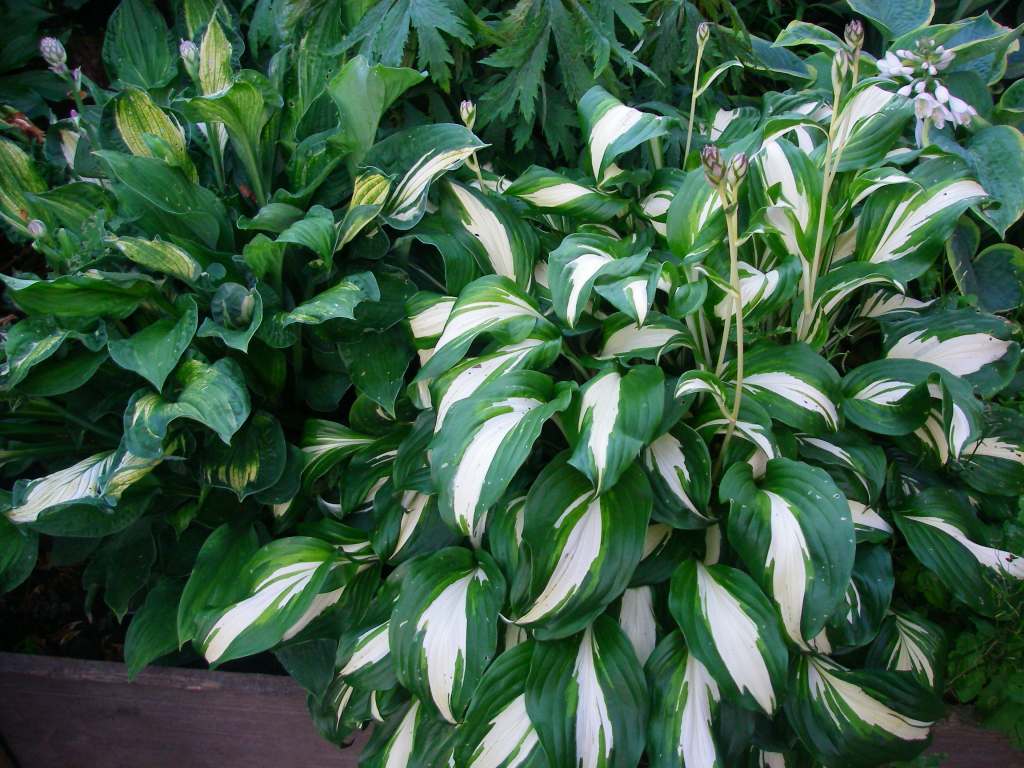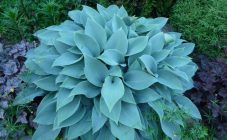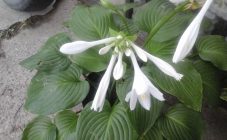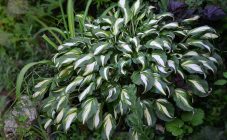Hosts are perennial garden plants that are decorative not so much with their flowers as with variegated leaves. Hosta Whirlwind is a herbaceous perennial variety with tricolor foliage, bred from the sport of hosts Fortunei Hyacinthina in 1989 by John Kulpa.
Description of the plant
Hosta Wirlwind is surprisingly decorative with its slightly curling leaves. The sport, formed from a hybrid with a green tint of foliage, shows a whirlwind of cream-white in the center of the leaf. During the summer, the middle, painted in a light shade, turns into a light green with veins of green.
Sport is formed from the shoot of the mother plant, which begins to show external qualities that are different from the original. Sport behavior can be unpredictable, as when it grows over many years, sport can take back the traits of the mother plant.
Hosta Whirlwind description:
- Height - 40-50 cm.
- Width - 80-100 cm.
- The bush is compact, has a regular, rounded hemisphere, densely leafy.
- Leaves are heart-shaped, curling upward. Center color and waviness are more intense in plants planted in illuminated areas. The size of the leaves is 20 × 16 cm.
- Blossoming - from the middle of summer with lavender flowers.
- The growth rate is average.
- Pests - resistant to slug damage.
- Landing sites - suitable for border and container plantings, places near decorative ponds.
- Illumination - sunny areas with shade, partial shade, shade. The foliage is resistant to sunburn.
- Reproduction - dividing the bush.
Agricultural technology of cultivation
Hosta reproduces by dividing the bush, so for planting it is necessary to purchase the rhizome of the plant. Saplings can be with an open root system, but mostly it is better to purchase grown specimens in pots.
Perennial is able to grow on soils with different neutrality. On fertile soil, it forms a ball of leaves faster and shows a higher decorative effect.
You can choose almost any place for landing the Whirlwind hosts in terms of illumination. But a feature of plants that have light spots on the leaves is their preferred growth in illuminated areas, where the difference in color between the center and edge of the leaf is better manifested.

Hosta reproduces by dividing the bush, so for planting it is necessary to purchase the rhizome of the plant
When planting a hosta in a sunny area, you should still take into account its need for shading during the hottest midday hours. To do this, you can plant a perennial near taller perennials or trees. In the full shade of the Wyrlwind variety, the leaves will curl less and go completely into a green tint.
Landing hosts:
- a divided bush together with an earthen lump can be planted throughout the warm season;
- purchased rhizomes are best planted in spring;
- in spring, plants are transplanted after the end of return frosts;
- the planting hole is made according to the size of the rhizome;
- drainage from pebbles or broken bricks is poured to the bottom, which will save the roots from decay;
- a mound of fertile soil is poured onto the drainage, onto which the plant is released, evenly spreading the roots;
- holding the seedling, the planting hole is completely covered with soil, slightly crushing it to fill in all the air spaces between the roots;
- the root collar is not buried, but raised a few centimeters above the soil surface;
- the planted cut is watered abundantly at the root, watering is repeated after a few days.
When planting a plant in containers, you should choose a container size with a margin for root growth. Most often, pot growing is used temporarily, for example, for growing small plants.
Hosts look good in planting 3-5 pcs. Overgrown plants in a group are less filled with weeds. Mulching helps to avoid weeding and loosening. The mulch for the host requires a large one, because a dense grass cushion under the bushes can cause rotting of the root collar. Pine bark or shredded tree branches can be used to cover the soil.
Plants respond well to top dressing, which can be done up to three times per season, as well as adding fertilizer to the soil when planting. Organic fertilizers include manure, chicken droppings and mullein.
Mullein is diluted with water in a ratio of 1:10 with the addition of mineral fertilizers in the amount of:
- 10 g of ammonium nitrate;
- 20 g superphosphate;
- 10 g of potassium sulfate.
For growing hosts, it is also convenient to use ready-made liquid fertilizers, produced specifically for ornamental perennials.
For the winter, the hosta is not covered, only the leaves are cut off at the root until frost. Leaves not cut for winter rot in the spring, creating an environment for diseases. Each year, the plant grows new leaves, and as the rhizome develops, they become denser and larger every season. The host shows the maximum decorativeness for 4-5 years of cultivation.
Advantages and disadvantages
The Wyrlwind hosta variety is unpretentious in care, grows stably and easily, therefore it is suitable even for novice growers.
Other advantages of the variety:
- does not belong to new products, therefore it has an affordable cost;
- grows quickly, in contrast to miniature and dwarf varieties;
- forms a compact bush;
- grows in any area;
- little affected by slugs.
Choosing a frost-resistant hosta, the gardener will not find any flaws in the herbaceous perennial.
Hosts, known in Japan and China for over 1000 years, have recently become popular in Russia. Khosta Whirlwind, changing the color of the leaves during the season, is picturesque in a garden planting, favorable to the neighborhood with other plants and only gains its beauty over the years.
